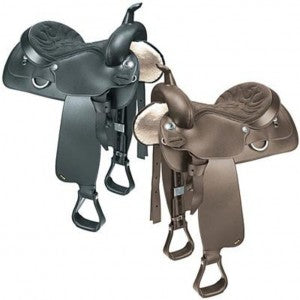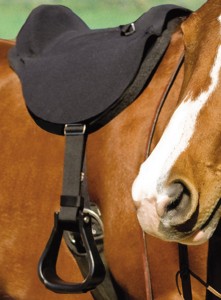Find the Perfect Fit: Saddle Fitting Instructions & Tips
Purchasing a horse saddle can be a confusing endeavor in today’s market of saddles. Saddle fitting has become a big discussion in the equine industry. In the days of old, the variety of saddle trees was fairly limited, but so were the variety and breeds of horses being used. A cowboy in the old west traveled from ranch to ranch riding many different horses with the same saddle.
However, the horses used for ranch work were somewhat standard in body type. The U.S. Calvary used a number of horses with only a few basic saddle trees. Again, the standard of horse conformation was fairly standard. Today we have an endless variety of breeds and body types, not to mention the number of riding disciplines being practiced. An improperly fitting saddle can be uncomfortable for both horse and rider.
One of the major factors in fitting a saddle to your horse is the type of bars in the saddle. The bars of a saddle are the two internal structures that run down the length of the saddle. The bars distribute weight across the horses back. You cannot actually see the bars unless you take your saddle apart. Regardless of the type of bars, saddle fit will vary from saddle maker to maker because there is no actual exact standard measurement to identify the different bars. Here are some general descriptions:
- Quarter Horse Bars (QH) - for slim running type builds such as a thoroughbred or thoroughbred cross quarter horses, mixed blood decent, horses with a higher pitch at the withers. Average is 5 ¾” gullet.
- Semi-Quarter Horse Bars (Semi-QH) – very little difference from the QH bars, built for the medium back horse that is narrow through the neck and shoulders. This is the most common tree in a western saddle. Average is 6” gullet.
- Full Quarter Horse Bars (FQH) – made to fit a wide back horse with flatter, rounded withers, sometimes referred to as mutton withered. FQH bars better fit the foundation, “bull-dog” body type. Average is 7” gullet.
- Draft Bars – best fit the wide flat back of the draft breeds with little or no evidence of withers. Average is 8” gullet.
Keep in mind, there is no such thing as a “perfect” fitting saddle. Let’s face it, most of us cannot purchase a saddle for every horse we ride or for every stage of our horses physical development. Purchasing a well-made, quality saddle that will fit the general body type of the horse breed you prefer is the best bet to achieving good fit on most horses you ride. It’s important to understand how saddle pads can accommodate your saddle to most horses. However, if you ride a variety of breeds and sizes, you may very well need to invest in multiple saddles.

Wither pad for high withers
Ideally, the topline of a horse should be equal; meaning the withers to the croup should be the same height. When the haunches are higher than the withers, the horse is built “downhill” and may need a wither pad to balance the fit of the saddle. A sway back horse will have a gap area under the saddle -- the saddle will only be making contact on the front and back end. This is often found with older or poor body condition horses.
A bridge pad can fill this gap, allowing your saddle to fit properly and preventing rubbing of the withers and loins. So, you may be wondering how you know if your saddle fits properly. Stand your horse on level ground; place the saddle on the back with no pad underneath. You should be able to stack two or three fingers between the pommel and the horse. If it’s less, the saddle may be too wide; more could indicate that your saddle is too narrow. Sweat patterns are a good indication of how and where your saddle is resting on your horse's back. Dry spots will signify that your saddle is not making contact with that area. Rubs or hair swirls can indicate rubbing.
A saddle that's used repeatedly and rubs will cause white spots on your horse's back or withers. Check your horse for tenderness along his back, withers and haunches. A saddle that rubs can cause a number of issues for your horse. The attitude and movement of your horse may also be a good indicator that something is wrong. If your horse is unable to move freely, pins his ears and nips at the saddle, or just appears to be uncomfortable when wearing it, you may need to consider the fit of your saddle. A gaited horse may not move as freely if the saddle constricts his shoulder movement.
A mounting step helps you get on your horse Never over-tighten your front cinch. The tighter your cinch, the more pressure the horse will have on his back before you ever get in the saddle. If you have problems with your saddle rolling, try using a different pad or a wider cinch. Also, a stirrup is to “help” you bounce onto your horse, not to pull your horse over while crawling up.
If you’re having trouble mounting, invest in a mounting step or a step-up stirrup. The flank cinch should be snug but not tight. If the rear of your saddle is rocking back and forth or up and down, use your flank cinch to prevent movement and decrease rubbing. It’s simple to attach a flank cinch to most western saddles. Never leave a flank cinch hanging loosely. The horse or rider could be injured by hanging a foot in a loose hanging flank cinch.
Also, keep your saddle pads and cinch clean from debris. A matted saddle pad or cinch can cause unnecessary rubbing.
Soft ride saddle Saddle fit involves a number of factors: the saddle itself, the pads, the horse and you, the rider. Horsemanship skills also affect the saddle fit. If the rider is not balanced and in synch with the horse, the weight will not be balanced enough to allow for a good saddle fit.
The less advanced the horsemanship skills, the more issues a rider will likely experience with saddle fitting issues. Jeffers Equine carries a wide variety of saddles and accessories, both for Western and English style riding. “The world looks better from the back of a horse” ~ Mary Ann Kennedy Christy has been riding, training, and handling horses for 25 years including several years in the rodeo circuit.



